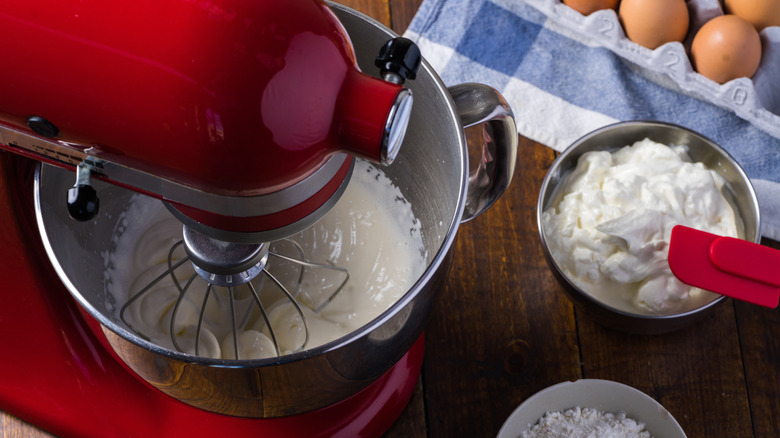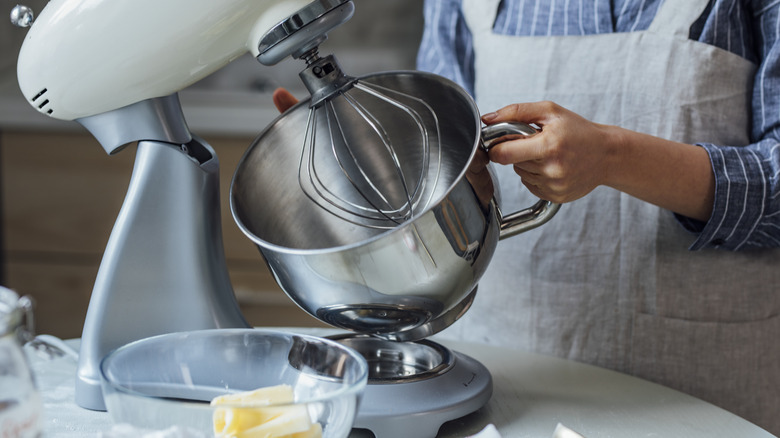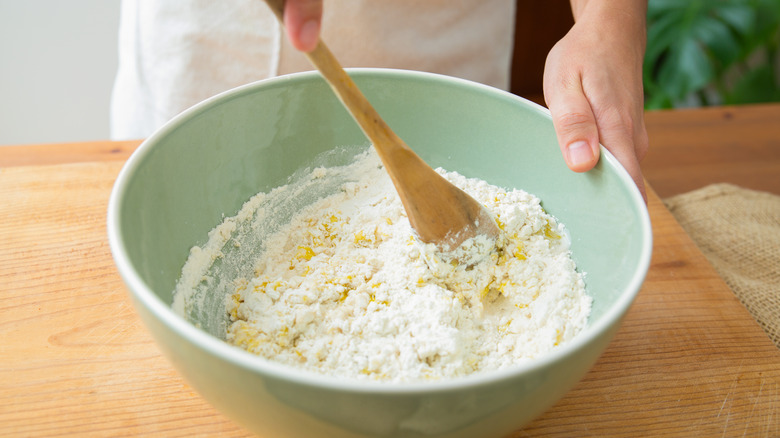Why You Need A Second Bowl For Your KitchenAid
Ah, the KitchenAid — the dream appliance of virtually every home chef or aspiring baker. It's one of the most beloved and versatile kitchen tools worth investing in. When you consider the sheer number of KitchenAid attachments that exist, from a food processor to an ice cream maker, it's pretty hard to think of things this mixer can't do. Want to make fresh, homemade pasta or zucchini noodles? It can handle that. Need to shred chicken or pull pork? Yup, you can use a KitchenAid for that, too.
With how handy the KitchenAid is, having only one mixing bowl can feel limiting at times, especially since some are better suited for certain tasks than others. Whether you're whipping up different colors of frosting or combining wet and dry ingredients separately, chances are you'll quickly become annoyed from having to wash your KitchenAid's bowl mid-recipe. So, if you're looking to get the most value out of your stand mixer and save time while cooking and baking, buying a second mixing bowl (or several) is a must.
Make the most of your time in the kitchen
Alongside the many accessories that help you prep and combine your ingredients with precision, the mixing bowl is one of the most important components of a KitchenAid. After all, it's pretty challenging to prepare any recipe without an adequate container to hold everything.
Whether you're making a time-sensitive or labor-intensive meal, having a second mixing bowl can help speed up prep time. From basic buttermilk pancakes to a rich, tiered chocolate cake, it's common for recipes to call for dry and wet ingredients to be mixed separately before combing them. While you could use a regular mixing bowl to do one part by hand, a KitchenAid bowl allows you to automate mixing for each step. This will save you time so you can get ahead on other parts of the recipe or complete lingering kitchen tasks.
Investing in a second mixing bowl for your KitchenAid can also make cleaning up more convenient. If you're limited to only one bowl, you might find yourself having to transfer ingredients to wash it once or even multiple times while in the middle of cooking or baking. This can create more dishes and steal away precious prep time. For instance, if you plan to mix dough with your stand mixer, you'll need to transfer it to proof in a separate bowl and wash the first one before you can use your KitchenAid again. An additional mixing bowl, such as one designed for bread, can streamline your baking process and reduce time spent at the sink.
Choosing different bowls for your KitchenAid
As with other baking tools, mixing bowls are made from many different materials, including stainless steel, ceramic, and tempered glass. Stainless steel mixing bowls are popular thanks to their heat conductivity and the material's lightweight compared to glass and ceramic, which makes them easy to handle. Glass bowls, on the other hand, often have measurement markings for conveniently portioning ingredients, and their transparency allows you to keep a close eye on your mixture. Ceramic bowls can also be used in the oven if needed. Both glass and ceramic KitchenAid mixing bowls usually have pouring spouts so that you can easily transfer wet ingredients.
Each of these types can be useful for completing a range of kitchen tasks so if you're considering an extra KitchenAid bowl, you'll likely want to choose different ones so you can tackle a variety of tasks at once. Say you're making cake pops; while combining your cake mixture in your Kitchenaid you might also want a mixing bowl for melting chocolate that you can pop in the microwave or heat over a double-boiler. For that, you'll need a glass or ceramic KitchenAid bowl in your arsenal. Or imagine you're creating a sponge cake with layers of whipped cream; because of its heat conductivity, stainless steel is great for chilling freshly whipped cream in the fridge or freezer while you combine your cake in another spouted bowl perfect for pouring the batter into a pan. With a little practice and the right combination of KitchenAid mixing bowls, you're sure to find a few ways to improve your cooking and baking experiences.


